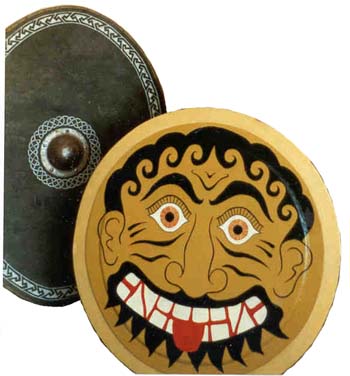Like the section of mail armour, this section provides advice on making armour, along with some general discussion of the armour type.
A hoplite was a soldier defined by his use of a type of shield called a hoplon, which was a very odd shield indeed. More of that later. For the moment, some pictures...

Lloyd, wearing hoplite panoply. The picture shows the cuirass, covering the torso, with its brass scales, and its blue and white pteriges; the inside of the hoplon, complete with authentic fittings; the suspension of the sword; iron greaves. Strictly speaking, the legs should be bare at the thigh, but even Greeks wore more clothes when it was parky.

Two shields. At the front we see the face of the hoplon, with authentic design, and behind we see a Romano-British shield.

Lloyd wearing the outfit at Hopwain, an event he organised for a live-action rôle play festival. He is playing the character of Earl Berwick, and beside him are bodyguards with the confusing names Castel and Stennel, which Lloyd seldom got the right way round.
A hoplite panoply is clearly a wonderful thing, I must make one!
Well, then possibly I can help you there. The panoply included a spear and a helmet, which I have not illustrated. My helmet is not brilliantly authentic, and my spear is very plain. The proper way to make a helmet involves hammering a thick piece of metal over over a former, using a chisel-headed hammer, and a great deal of skill. I can offer help with the greaves and the cuirass, and my writings on the shield and the spear should shed some light on how to go about things.




